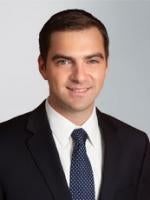On January 4, 2019, the United States Patent and Trademark Office (“USPTO”) released a significant, much-awaited revision to its patentable subject matter eligibility guidance.1 The “2019 Revised Patent Subject Matter Eligibility Guidance” (the “Guidance”) changes the USPTO’s administrative procedures for determining whether a patent claim is directed to a judicial exception (e.g., a law of nature, natural phenomenon, or abstract idea) and thus ineligible for patent protection. The Guidance comes in response to numerous stakeholders’ calls for clarification of the patent examination process under 35 U.S.C. § 101 and consistent application of court precedent by patent examiners. It is effective as of January 7, 2019.
As revised, in Step 1, examiners are to determine whether the claimed subject matter is directed to a statutory category of patentable subject matter (i.e., a machine, manufacture, process, or composition of matter). In Step 2A, prong one, examiners must evaluate whether the patent claim recites a judicial exception, and in prong two they must evaluate whether any recited judicial exception is integrated into a practical application. If a claim is not eligible at Step 2A, in Step 2B examiners must evaluate whether the claim has additional elements that amount to significantly more than a judicial exception and form an inventive concept. The USPTO reports that Steps 1 and 2B of its prior eligibility analysis are unchanged, but Step 2A is revised in multiple ways, most notably to include a two-pronged inquiry having more decision points at which patent claims may be found eligible.
First, Step 2A restricts the universe of patent-ineligible “abstract ideas” to three categories previously recognized by the courts: mathematical concepts, certain methods of organizing human activity, and mental processes. Under this framework, patent claims are automatically eligible unless they are directed to one of these three categories, except in “rare circumstances” ultimately requiring the intervention of the Technology Center Director and a justification for any subsequent determination of abstractness. Second, Step 2A provides that a patent claim reciting a judicial exception is not “directed to” the judicial exception if the judicial exception is “integrated into a practical application of the judicial exception.” Each of these revisions introduces a significant new stopgap in the patent eligibility analysis, making it more likely that a given claim will survive.
In Step 2A prong one, where examiners must evaluate whether a patent claim recites a judicial exception, the claim is automatically eligible at prong one if it does not recite such an exception; if it does, the claim requires further analysis under prong two. In addition, to determine whether a claim recites an abstract idea under prong one, examiners must now (a) identify the specific limitation(s) believed to recite an abstract idea; and (b) determine whether they fall within the subject matter groupings enumerated above. If they do, the analysis proceeds to prong two.
In Step 2A prong two, examiners must evaluate whether the claim recites additional elements that integrate the judicial exception into a practical application. If it does, then the claim is eligible at prong two; if it does not, the claim requires further analysis under Step 2B. A claim that integrates a judicial exception into a practical application will apply, rely on, or use the judicial exception in a manner that imposes a “meaningful limit” on the judicial exception, such that the claim is “more than a drafting effort designed to monopolize the judicial exception.” Some examples of meaningful limits are ones that: (i) reflect an improvement in the functioning of a computer or other technology; (ii) implement a judicial exception with a particular machine or manufacture; or (iii) effect a transformation or reduction of a particular article to a different state or thing. Non-meaningful limits include ones that: (i) merely include instructions to implement an abstract idea on a computer; (ii) add insignificant extra-solution activity; or (iii) do no more than generally link the use of a judicial exception to a particular field.
In Step 2B, examiners will continue to consider whether an additional element or combination of elements: (i) “adds a specific limitation or combination of limitations that are not well-understood, routine, conventional activity in the field, which is indicative that an inventive concept may be present;” or (ii) “simply appends well-understood, routine, conventional activities previously known to the industry, specified at a high level of generality, to the judicial exception, which is indicative that an inventive concept may not be present.” The Guidance is clear that even though such considerations may have factored into the analysis of Step 2A, they should be reconsidered at Step 2B. For example, the Guidance states that for a claim reciting a mathematical equation and a series of data gathering steps, the data gather steps might be considered insignificant extra-solution activity at Step 2A, but at Step 2B their combination could give rise to an unconventional method including an “inventive concept,” rendering the claim eligible at Step 2B.
As suggested above, the Guidance also contemplates “rare circumstances” in which an examiner believes a claim limitation that does not fall within the enumerated groupings of abstract ideas should be treated as reciting an abstract idea. In such cases, the examiner must evaluate whether the claim as a whole integrates the recited “tentative abstract idea” into a practical application. If it does, the claim is eligible; if it does not, the examiner must evaluate the additional elements individually and in combination to determine whether they include an inventive concept. Only if a claim fails this last step does it proceed to the Technology Center Director for approval to treat the claim as abstract, with a written record of the approval and a justification required to treat the claim as being directed to an abstract idea.
The Guidance marks a positive step forward for patent owners, both in terms of clarity of the examination procedure and opportunities to argue for eligibility of patent claims. Indeed, the Guidance states that any claim considered patent eligible under prior guidance should be considered patent eligible under the Guidance. However, some significant ambiguity will inevitably remain during examination. For example, it is unclear what applications will be considered “practical” and what additional limitations will be considered “meaningful.” Furthermore, it is unclear at what point a claim that at some level arguably reflects a judicial exception (e.g., a software claim that at some level reflects a “mathematical concept”) is transformed into patent eligible subject matter. Although not a perfect fix, the Guidance looks to be a significant step forward for patent owners and clarity of the patent eligibility analysis.
- On the same day, the USPTO also released additional definiteness guidance regarding functional claiming in software patents under 35 U.S.C. § 112. We will address that guidance in a separate post.





 />i
/>i

